Solliden Style Chisel Handles
Article Contributed by Randall Nelson
Swedish chisels, epitomized by the production of the EA Berg Company, are world-famous for their superior steel, amazing cutting ability and edge retention. To wood workers and tool collectors, they are equally well known for the handsome design of the wooden handles found on the late 19th and early 20th century tools, which featured a standardized, yet complex turned pattern of plain Birch or highly-figured Masur Birch, as well as a fancy brass ferrule with decorative lines of knurling and a hammer ring at the top, to prevent splitting of the handle during use. When new, they also had a golden color from the shellac finish.
My introduction to these tools, in the early 70’s, was when I started my apprenticeship with a Japanese sculptor who had been one of my professors in college. He had several EA Berg chisels and regarded them highly. I remember how those golden Birch handles stood out from the other chisels on the rack in his studio. As a boy, I had heard stories about my great-grandfather, Oscar George Nelson, who had been a finish carpenter in Sweden (somehow, the possibility of a Swede being a Finn always made everyone laugh). Now, I imagined he must have used such tools and I wanted some of my own, but as soon as I started inquiring about them, I was told I was wasting my time, since “the factory had burned down in the 50’s and they were no longer available”. I heard this same story from hardware store owners and from other wood workers, but I kept looking. At a flea market, I found a couple of old, short butt chisels marked Gensco- the handles were the right shape, but they were a yellow-orange plastic! I bought them anyway and they worked OK, but I lusted for the long-bladed Berg chisels with the Birch handles like my teacher had.
 Plastic handled Gensco chisels
Plastic handled Gensco chisels
Eventually, I found a few wooden handled Swedish chisels in a surplus tool shop on Canal Street in NYC. They were all butt chisels and each had a golden sticker on the handle that said Solliden Sweden SAB.
I was so pleased with them that I couldn’t wait to show them to my teacher. He took one look at them and said “Cheap, not the best quality steel. Soft Beechwood handles, they won’t last. These are tools made for the amateur- just Handy Andy grade.”
His assessment that day of my Solliden chisels seems to have been echoed by the greater tool-using and collecting public for everything that wasn’t stamped EA Berg. When it comes to Swedish chisels, in most people’s minds there is EA Berg and then there are just some other tool-making imitators. However, I still have those Solliden chisels I purchased so many years ago on Canal Street and have used them, quite successfully, on many projects. Still, for many years, all I wanted was Berg chisels and I sought them avidly, at flea markets and old tool shops and I slowly added to my collection. Then along came Ebay and the ability to find and purchase old tools constantly! With time, I started to appreciate what a wide array of different Swedish chisel makers there must have been, since I was constantly seeing unknown brands of Swedish chisels available on Ebay. Many had colorful, interesting stickers on the handles.
 A wide array of brands using Solliden style handles
A wide array of brands using Solliden style handles
The pursuit and study of Berg tools started to slip into the background. I began actively collecting as good an example of each different brand as I could find and afford. As I acquired more tools I started comparing blade designs and sticker designs, looking for similarities.
I was looking at a Beaver brand chisel and a Castor brand- the stickers are almost identical, but the Castor is in different colors and in Spanish. Then I started actually looking at the handles- they were also identical. When put side to side, everything lined up perfectly. These handles had obviously been made on the same machine, using the same pattern cutter. I looked closer and then noticed something else- they looked very similar to the handles on my old friends. I got out my Solliden chisels and lined them up with the Beaver and Castor- the handles were all identical. I now call this style of handle Solliden Style, for want of a better name. I started laying out all the different brands I had collected that still had the original handles. I was surprised at how many were identical, or nearly so. This could not just be a coincidence. I was even more surprised to discover slight variations from one handle to another, even within the same brand of tool. But this should be expected also, since wooden handles would have much more possibility of slight variations than a plastic handle, because of the complex elements that must come together to make a Swedish style wooden chisel handle that works properly. When compared to the relatively simple task of injection molding a plastic handle you soon realize why the wooden handle disappeared from Swedish chisels once plastic technology became readily available.
After looking at many chisel handles, there seem to be three basic mass produced variations on the standard Swedish wooden chisel handle type, plus a few that seem to have been more idiosyncratic, so possibly they were user-made or made in-house by a small company as part of their own production. The three basic types are: #1. Berg/Jernbolaget, #2. Solliden and #3. Gensco. Each type has a few basic characteristics that help to make it recognizable. There are also several specialty handles designs that I may get into at a later date, but let’s stay with the standard handle pattern for now.
The first, #1., should rightly be called Jernbolaget/Berg, since the Jernbolaget Company, which started in 1811, is far older than Berg, which started up in 1879. Jernbolaget’s handle design was probably copied by Berg when they went into wooden chisel handle production for their tools. I have seen a few very early Berg chisels and the handles were either Boxwood, in the semi-octagonal design popularly called the London pattern, or are turned from what looks like English Oak.
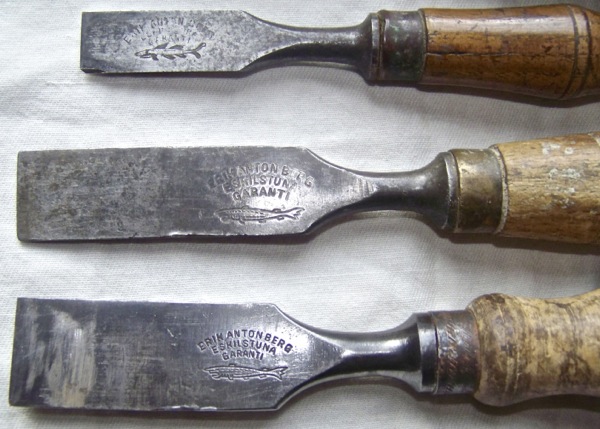 Three early Berg chisels, the top one has a handle of English oak
Three early Berg chisels, the top one has a handle of English oak
This would make some sense, since I recall reading that the early Swedish edge tool manufacturers used the industry in Sheffield, England as their model. However, I’m not sure why would Berg would need to import handles from England for their early tools. Anyway, Jernbolaget handles and Berg handles are virtually indistinguishable in overall design.
The typical #1 handle comes in six graduated sizes, has three pairs of finely cut grooves and has a slightly “squashed” appearance to what I call the pillow area, the rounded swelling just above the ferrule; as if the handle had been hit quite hard and had compressed this area down just a bit. This “squashed” effect is even more pronounced in the pattern for the socket chisel handles. The transitional shaft between the Pillow and the Upper Barrel is quite robust, hopefully giving plenty of wood for holding the tang of the chisel without the wood cracking. They are all made of Birch, either Masur Birch or plain Birch. I have never seen a single chisel from either company that has an original factory handle that is made from Beechwood. The ferrules always have two rows of slightly angled knurling, with the lines cut very fine. These lines can be angled to the left or to the right; I have examples where the two bands go in opposite directions. I have also seen many examples where the ferrules are not the regular brass but are steel or chromed brass. For either company, the hammer ring at the top of the handle can be held on with two brads through holes in the ring or (usually later) dimpled into the wood. When you find a tool that has two small, headless brads driven in above the ring, clamping it in place, this is usually an indication of a Jernbolaget tool, or a very early Berg tool. Another indication of maker is the stamp, in the wood of the handle, “Made in Sweden”. I have only seen this on Berg chisel handles.
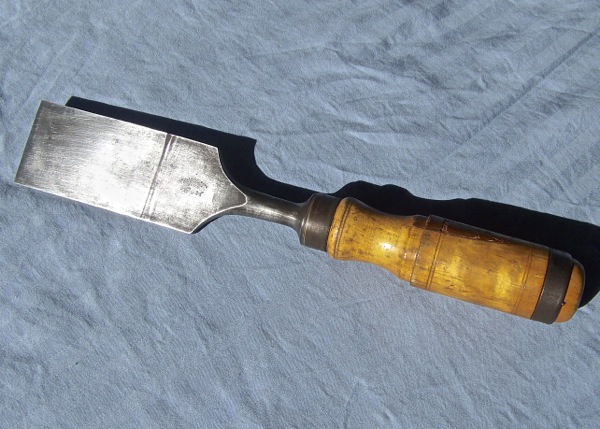 An early 2” Berg chisel with a Jernbolaget style handle
An early 2” Berg chisel with a Jernbolaget style handle
 A group of Berg tanged chisels
A group of Berg tanged chisels
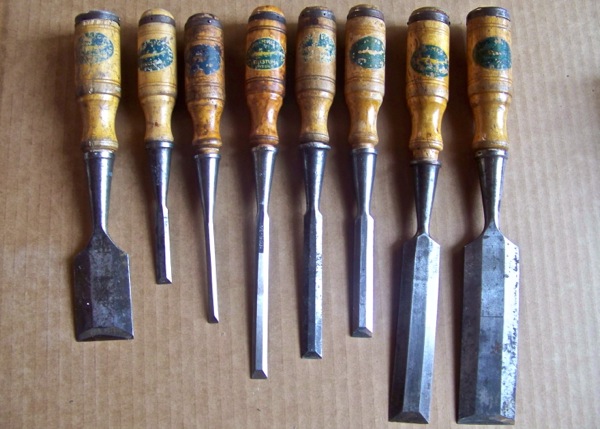 A group of Berg socket chisels
A group of Berg socket chisels
The characteristics of #2., the Solliden type handle, first start with the material, Beechwood.
Overwhelmingly, the Solliden style handle is made of this wood, although upon closer examination I have found a few that are made of Birch, usually in the larger handle sizes. The next thing to look at is the brass ferrule- if it is brass with two lines of coarse, vertical knurling, then the handle is Solliden style, no matter what the blade style or maker. The typical Solliden style handle has a very “globular” pillow above the ferrule and a slightly thinner transitional shaft. The grooves are also done in three pairs, but are typically cut deeper than will be seen in a Berg or a Jernbolaget handle. The hammer rings are usually shiny black and are held on by two small brads through holes in the ring. They typically come in only four graduated sizes, to accommodate any chisel from 1/8” up to 2”, which often results in some tools where the blade and the handle looked slightly out of proportion. Berg would make much larger handles for their larger chisels and gouges, typically using six graduated sizes for their handles. I have only one Solliden style handle that was made for a socket chisel- this is for a Wallins chisel, which is only marked Wallins, Sweden. I have a later Wallins chisel, with a red plastic handle, that is marked Wallins, Lidkoping, Sweden.
I bring this up because both Berg and Jernbolaget always included Eskilstuna in their blade stamps, whenever there was room. Tools using Solliden style handles often have no indication of where or by whom they were produced, other than the generic “Made in Sweden” stamp.
The third mass-produced style is for Gensco, which stands for General Steel Company and was an American company based in Chicago.
This company manufactured pre-fabricated steel buildings after WW2, but they also imported Swedish chisels to the US. Gensco chisels with wooden handles say, on the bottom of their label, in tiny print, “printed in USA”. Gensco chisels had very nice Masur Birch handles that were identical to Berg handles, except they are typically shorter in the barrel- the handle for a Gensco 2” butt chisel is ¾” shorter than a Berg handle of the same diameter. Gensco tools were made by the Eskilstunasteel Company, which also made the Esteel tools, but I have yet to acquire any chisels still with their original handles from those two brands to use as references for any further comparisons.
To make a wooden chisel handle, pieces of wood the proper size and quality must first be chosen and roughly shaped into blanks, then cut to length, chucked into a lathe and turned, either individually or in a gang, depending on the type of equipment available. A commercial duty lathe will use a purpose-made pattern cutter to form the handle profile in one step, unlike the series of cuts with different lath chisels an individual would need to do to produce such a handle on a regular shop lathe. The tooling needs to be quite precise, so that the brass ferrules and steel hammer rings fit snuggly when the handle is assembled. When making comparisons between different handles of the same general design, the place where I found the most variation was in the placement and depth of the horizontal grooves that typically appear in pairs in 3 different places on the standard Swedish chisel handle. Sometimes the grooves are heavily cut, sometimes they are barely visible or are more widely spaced. I would imagine the pattern cutters probably got dull rather quickly and needed to be re-sharpened, which could soon lead to minor variations in the spacing of grooves, depth of the shoulder, etc. These are the typical variations that show up most frequently. I think that, when handles match exactly in length, profile and grooving pattern, it is safe to assume that they were probably made at roughly the same time, on the same machine, in the same factory.
The obvious questions are: where was that factory, who owned it and what was its name? Is there any truth in the story I was told nearly 40 years ago, that the handle factory burned down in the 1950’s? A later clarification that I heard of this story was that it was the Berg handle factory that burned, and that it had made all the wooden handles, for Berg as well as all the others. My research would indicate this idea isn’t true, since I have never seen any Berg tool that had an original Beechwood handle with a Berg sticker on it. Also, the patterns between styles #1 and #2 are just too dissimilar, the brass ferrules are not the same, the sizes are different- all of this would indicate a separate factory that was producing lower cost handles for the second tier tool producers. In Sheffield, England, there were traditionally always smaller companies making limited production runs of tools, known locally as the “little masters”. I suspect this was also the case in Sweden, and the Solliden Style handle factory, whoever and where ever they were, produced the handles for the Swedish “little masters”.
This is a list of the different chisel brands that I have compiled, from my own collection and from looking at examples I can find on line, of companies that used the Solliden style handle. This is, of course, only a partial list, since new Swedish chisel brands seem to pop up every few weeks! Each “little master” chisel maker probably purchased the handles as they needed them, so these handles are found on all types of chisels. Some are long paring chisels or firmers, but most were produced as butt chisels. For example, I have never seen any actual Solliden stamped chisel that is not a butt chisel. The quality of the tools is also varied- my teacher was probably not too far off when he evaluated my Solliden chisels. However, I have seen some tools that use these handles that are of superior quality- the set of Svea chisels I have are beautifully made and most of them were made with Birchwood handles, while the Agersta and Handy chisels I have are a study in how many corners you can cut and still put something out for sale!
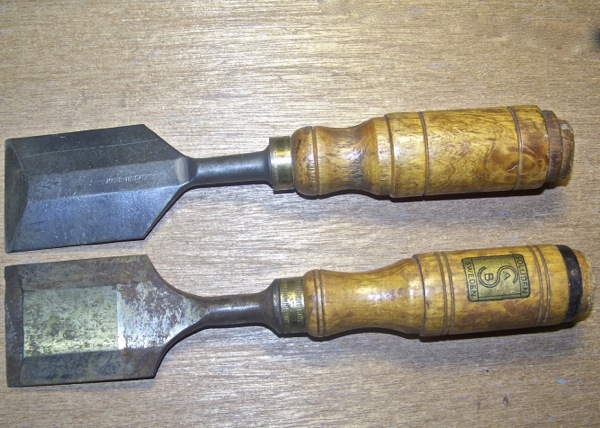 Comparison of 2” Agersta (top) and 2” Solliden chisels (bottom)
Comparison of 2” Agersta (top) and 2” Solliden chisels (bottom)
Anyway- the list of tools that I have found that used the Solliden style handle: Toledo, Tecomaster, Beaver, Castor, Krona, Waern, Asab, Svea, Svalling, Handy, Janport, Wallins, Swallow, Homestrand and of course, Solliden.
Article Contributed by Randall Nelson
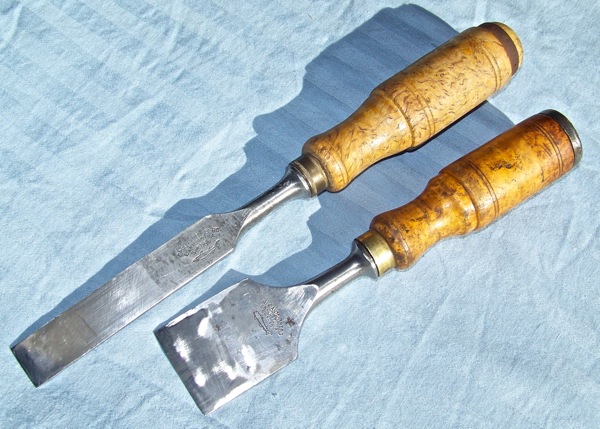
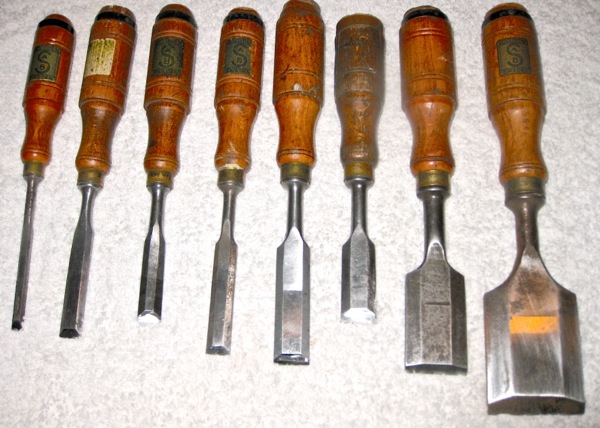
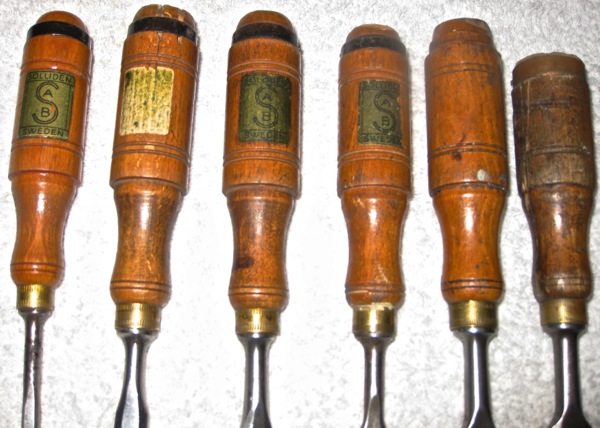

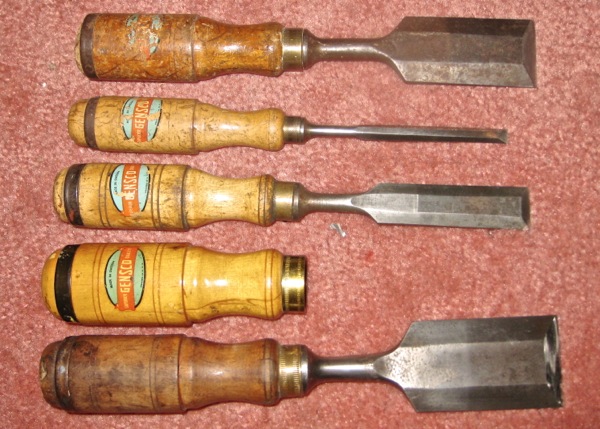
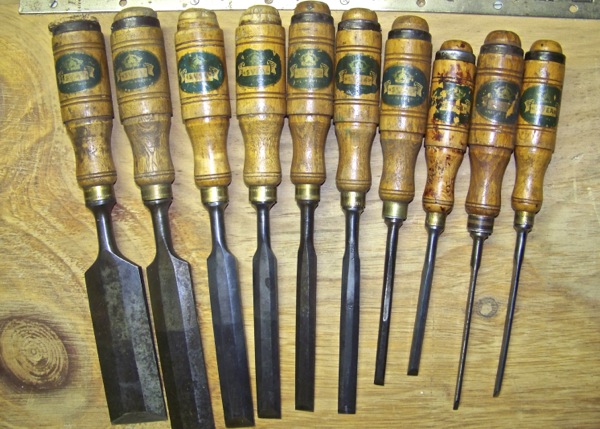
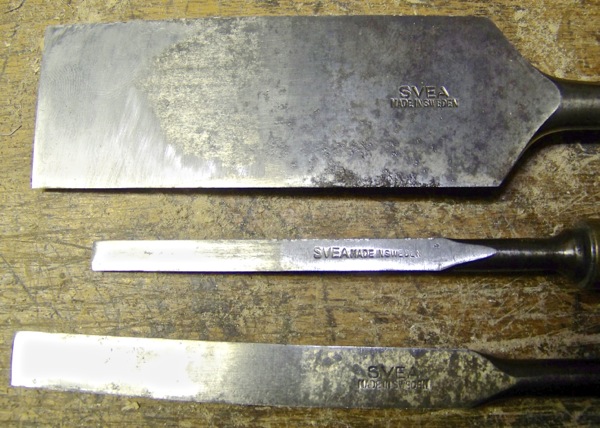
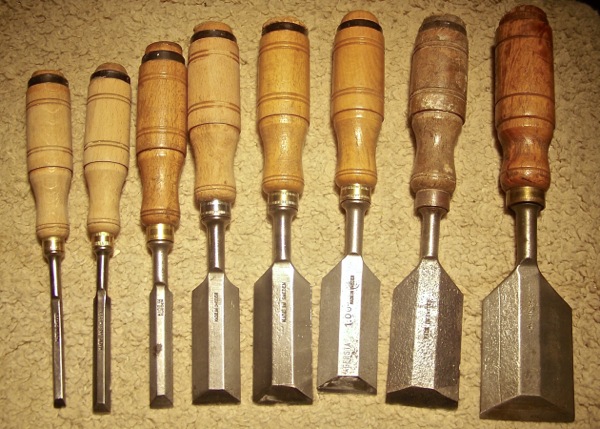
I have a set of E. A. Berg chisels with the Wallins style plastic handles. I have broken the handle on my favorite, the 2″ chisel. Can you help me find a replacement? Wood or Plastic? Thanks.
You can find something similar to the red Berg chisel handles on the Two Cherries USA web site.
https://twocherriesusa.com/product/plastic-handle/
It’s a good idea to check handle dimensions since a 2″ chisel is very hefty.
As an addition to the above article: another quick way to spot a Solliden style handle is, if the steel hammer ring is missing, the little “step” where the ring goes, between the barrel of the handle and the dome of the end. This feature is always present on Solliden style handles but never to be seen on any Berg, Jernbolaget or Gensco wooden handles. The hammer ring on Solliden style handles is typically thin and slightly rounded- over, to cover this “step”. This “step” is clearly evident in the above picture of the Svea chisel group, on the two handles that are missing their hammer rings.
I know this article is several years old now but it remains one of the best on the subject.
Last year I spent several months in a small town outside of Eskilstuna. There are several museums dedicated to medieval metal working, to farm equipment and even more than an nod to steam engines but nothing to indicate it had been a center of industry to some of the best edged-tools ever made. It came as a surprise to my carpenter friends that I sought out and used tools made in Eskilstuna.
Thanks for sharing all of the valued info. being a now retired carpenter and only recently discovered scandi type wood handled chisels,after a few years of British vintage renovation of wooden handled tools having that much more time to use my lathe.I have re-produced a few types of handles even the solliden type.I consider that Birch handles are probably the best use of this timber for them .
A good deal of British tool handles are either ash,oak or beech .Sourcing these materials is a full time Hoby boot sales are my market,there are usually a couple of old wood rolling pins to be found there of either ash or beech.Birch though is different story.
Very good article…thank you for all the research you’ve done. I have an old 1 1/4” Victor-A1 with the same handle and a solid steel ferrule. Never seen another like it but the chisel itself is exactly like my E.A. Bergs. Have you any info on Victor-A1?
I have not seen or heard of the Victor-A1 chisel brand. Do you have photos that you could send?
Birch: Good to see that you are still up and running! Anything new going on?
Thanks, Randall. Back at you. 🙂
We’ll have to do an e-mail catch-up sometime soon.
I sent pictures through your gmail account. Hope you can see find them
Got them. Thank you. 🙂